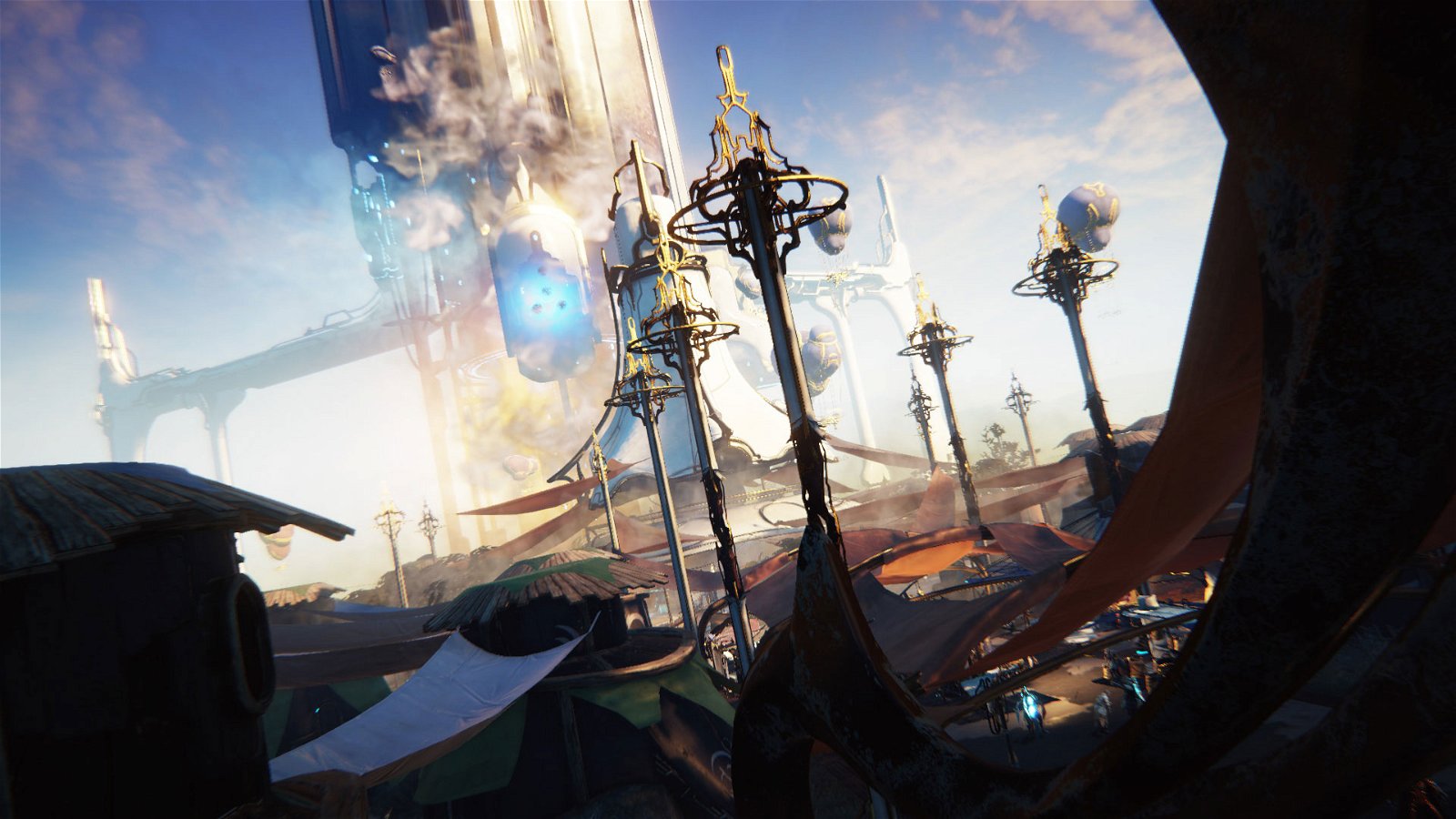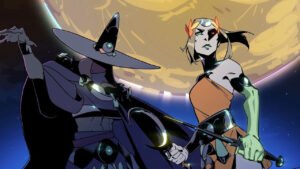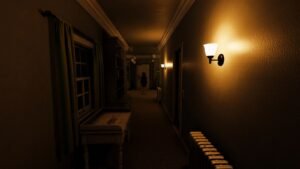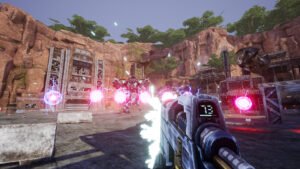Warframe’s four years have let to the game expanding drastically, from the basic third-person action game where it started its open-beta life. Its nebulous state of revision and exploration has led to some drastic innovations (the new parkour system for mobility), and some unfortunate fumbles (the Dark Sectors competitive territory-wars). So when something as unexpected as the Plains of Eidolon rolls out in front of me, I tend to become concerned.
It’s certainly visually stimulating. We’re introduced to Cetus, the ramshackle town of surveyors scavenging remains of a long-silent Orokin tower, through the flight of a moth-like insect flying across the skyline. It’s a place of contrasts with the golden, pristine towers and the hits of sticks and bustling market of spices and cages of vultures (hinted at to be a new companion option in the future), and in the towers themselves as inhabitants peel a thick, meat slab of bloody matter from beneath the white-and-gold masonry. They touted it as a more detailed look into a civilian settlement, an aspect of Warframe we’ve only now started to see.
Warframe has always had a minimalist, fluid storytelling, mostly because it’s accepted that much of the lore is changed constantly as its reworked and updated. Cetus is a look into the common element of Warframe’s universe, beyond its posthuman technology and haunting supernatural tones. It’s an element we’ve started to see in the quest storylines, and gives us an idea of why we’re fighting for ‘balance’ in the story, beyond just looting crates and stabbing fire-spewing clone commanders.
Upon departing the town through twin set of loading-friendly doors the Plains themselves become visible – wispy grass sways in the wind across a vast landscape. While three kilometers, as developer Steve Sinclair reveals, doesn’t sound impressive on its own for a video game, it’s a different direction from the procedurally generated corridors and winding ledges the game is built around up until now. As the Warframe moves out (community manager Rebecca Ford taking every opportunity to shoot birds that fly by), we see the river and the massive remains of angular ships – actually the bodies of the Sentients, artificial intelligences that once ravaged the solar system. Amid those remains, Grineer patrol, their bases looming in the distance or nestle along the river.
The Warframe fights the industrial Grineer on the ground, fishing with spears in the lake and holding up its catch, before calling its orbiter to summon an Archwing, a winged backpack that allows free flight. Now they soar over the landscape, avoiding shots from a hilltop fortress before landing to take out its sentries, all while the sun sets in the sky. As the Grineer suddenly flee, the final video shows a behemoth of pale branches and worn machinery rise from the river, a spectral Sentient bent on harvesting your parts to repair its fallen form. While we did not see this action, its assured to be a difficult, multistage encounter that relies on late-game powers and skills, something for those who’ve played from the early days.
They stressed a balance between new players an old. “I wake up in a cold sweat thinking that (Warframe) has stagnated.” he said, stressing that they’re trying to break new territory with this. Despite its more open field, it is still instanced, with squads of four hosting their own map, merely providing a much wider playing field than before. While not procedurally generated, Sinclair said that the missions would be, with their locations and enemy spawns randomized even if the terrain is not. While he suggested this was slated for late summer release, he did stress that this kind of change was not going to be done drastically, with the old mission types still having a place.
It makes sense, after four years of life to expand this way, but it raises questions about development. The Plains comes with a new design philosophy and new challenges, and the team has to develop this along with the old map types, which each come with their own playstyle and optimization. Such experiments are never certain, and helping them take root over the familiar structure may present challenges, as it did when Dark Sectors led to an aggressive, byzantine sub-community with making the game directly competitive rather than its original cooperative gameplay.
Other new elements such as customizable, modular weapons that can be assembled, given different movesets and stats (and individual names, apparently), and the aforementioned spear-fishing option suggest that this marks the beginning of a new development. It moves the game beyond the boss revisions and extra weapons and mission types previously seen. It also means a return to the potentially-buggy, haphazard days where the ‘Early Access’ status becomes more apparent, though this is essentially a finished game. Should this find leverage, however, we could be looking at some great potential regarding new bosses and enemies, or even missions.




